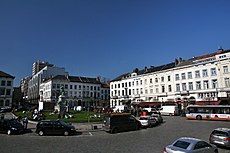Place du Luxembourg

Place du Luxembourg, view facing toward town, away from the Parliament.
|
|
| Location | Brussels, Belgium |
|---|---|
| Quarter | Leopold Quarter |
| Construction | |
| Completion | c. 1861 |
The Place du Luxembourg (French) or Luxemburgplein (Dutch) is a square in the European Quarter of Brussels (Belgium). It is better known by local European bureaucrats and journalists by one of its nicknames, "Place Lux" or "Plux".
The square consists largely of restaurants and bars which dominate the wide pavements, with some banks and other retail services, serving the employees and members of the neighbouring European Parliament as well as the other European Institutions and associated organisations which are mostly located close by.
In the centre of the square is a statue of John Cockerill, a prominent British-Belgian 19th century industrialist, which is a copy of the statue outside Seraing town hall in Liège. The figure of Cockerill is leaning against an anvil and surrounded by an industrial figures from period: a glassmaker, a mechanic, a puddler and a miner. Cockerill's motto, Work and Intelligence, are engraved upon the statue.
The Place du Luxembourg was a central feature of the Leopold Quarter, an area developed in the first few decades after the Belgian Revolution, and the most prestigious residential area in the capital for the bulk of the 19th century. The district had been designed in the 1830s, but the original design did not include provisions for a train station. When the new "Gare du Quartier Leopold" station was built in 1854, architect Antoine Trappeniers was commissioned to draw up plans for a large public square leading to the station building. Rue de Luxembourg/Luxemburgstraat was then in an embryonic state, and the square was created as its end point. The square was designed in a neo-classical style. It was designed to be as symmetrical as possible. Construction was carried out primarily between 1855 and 1861. The square was popular among merchants and restaurant and cafe owners due to its proximity to the station. One house on the corner of Rue d'Arlon/Aarlenstraat was at one time the home of Auguste Beernaert, Prime Minister of Belgium from 1884–1894.
...
Wikipedia
